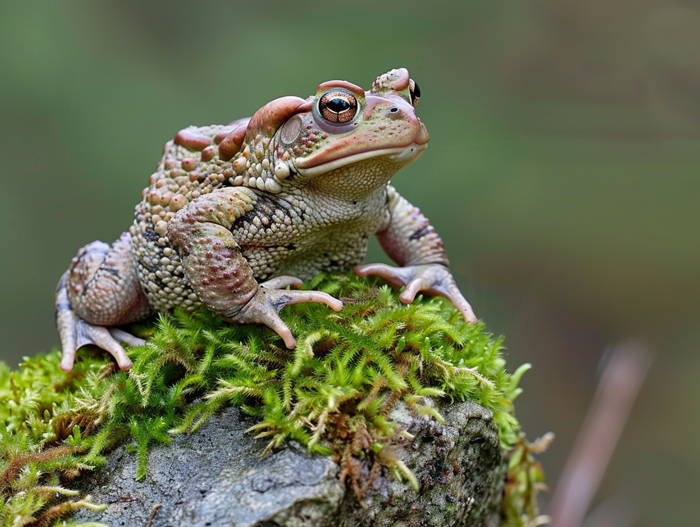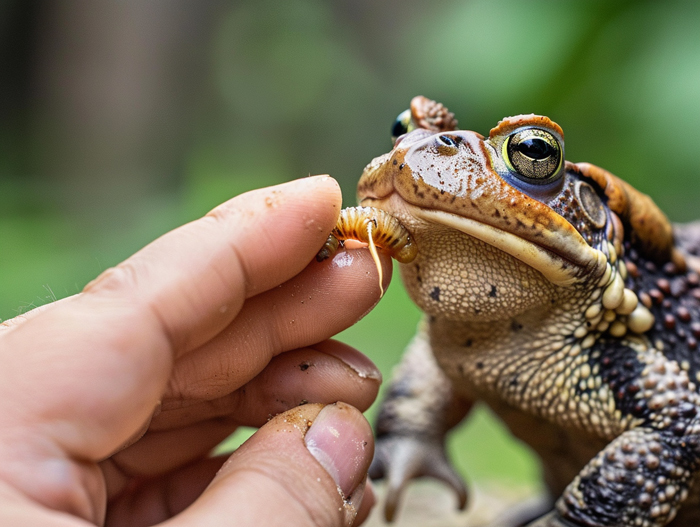Are you considering getting a toad as a pet? Toads are fascinating creatures that can make wonderful companions. In this text, you’ll discover essential tips on how to properly care for your new amphibian friend.
From creating the ideal habitat to providing the right diet, taking care of a toad requires attention to detail. With the right knowledge and care, you can ensure that your toad thrives in its environment.
Whether you’re a first-time toad owner or looking to enhance your existing toad care routine, this guide will provide you with valuable insights to keep your toad healthy and happy.
Key Takeaways
- Toads are beneficial pets for natural pest control, requiring minimal grooming and a diet of insects and commercial food.
- Setting up the perfect habitat involves considering enclosure size, ventilation, security, substrate, decor, lighting, heating, and maintaining appropriate temperature and humidity levels.
- Feeding your toad a varied diet of live insects like crickets and mealworms every 2-3 days is crucial for their health and well-being.
- Proper handling techniques include washing hands, gentle handling, avoiding stress or injury, and fostering bonding without forcing interaction.
- Watch for signs of stress in your toad, maintain a quiet environment, and seek veterinary help if needed for health issues, regular check-ups, and habitat cleaning.
Benefits of Having a Toad as a Pet

Natural Pest Control
- Toads feast on insects like beetles, mosquitoes, and slugs.
- Having toads in your garden can naturally control pest populations.
- Reduces the need for potentially harmful pesticides.
- Toads are hardy creatures that require minimal grooming.
- They don’t need daily walks or intensive exercise.
- Toads have a straightforward dietary requirement of insects and quality commercial food.
Setting Up the Perfect Habitat

Enclosure
When setting up a habitat for your toad, consider the following:
- Size: Ensure the enclosure is spacious enough for your toad to move around comfortably.
- Ventilation: Adequate airflow is essential for your toad’s health.
- Security: Opt for a secure enclosure to prevent escapes and protect your toad from potential hazards.
- Easy access: Choose an enclosure with easy openings for cleaning and feeding.
Substrate and Decor
Select the right substrate and decor for your toad:
- Substrate: Use appropriate substrates like coconut fiber, peat moss, or soil to create a natural environment.
- Hiding spots: Include shelters like caves or hollow logs for your toad to feel secure.
- Plants: Live or artificial plants can offer enrichment and hiding spots for your toad.
- Water dish: Provide a shallow water dish for soaking and hydration.
Lighting and Heating
Proper lighting and heating are crucial for your toad’s well-being:
- Lighting: Consider a full-spectrum UVB light to aid in calcium absorption and mimic sunlight.
- Heating: Ensure a temperature gradient in the enclosure with a heat source for basking.
- Thermometers: Use thermometers to monitor the temperature and humidity levels in the habitat.
- Lighting schedule: Maintain a consistent lighting schedule to regulate your toad’s day and night cycle.
Ensure these key elements are in place to create a suitable and comfortable habitat for your toad.
Feeding Your Toad

Dietary Requirements
Toads are carnivorous creatures, meaning they need a diet primarily of live insects. Your toad’s diet may consist of crickets, mealworms, or earthworms. It’s crucial to provide a varied diet to ensure nutritional needs are met.
- Offer food to your toad every 2-3 days.
- Adult toads typically require feeding less frequently than juveniles.
- Pay attention to your toad’s appetite and adjust the feeding schedule accordingly.
Remember, providing a balanced diet and adhering to a consistent feeding schedule are essential for your toad’s health and well-being.
Handling and Interaction
Proper Handling Techniques
- Always wash your hands before and after handling your toad to prevent potential transfer of harmful substances.
- Handle your toad gently and support its body to avoid causing stress or injury.
- Avoid sudden movements, loud noises, or handling your toad excessively to keep it comfortable.
- Handle your toad close to the ground to prevent accidental falls, which can harm your pet.
Bonding with Your Toad
- Spend time near your toad without necessarily handling it to allow it to get used to your presence.
- Offer food by hand occasionally to associate your presence with positive experiences.
- Avoid forcing interaction if your toad seems stressed or unresponsive, as each toad has its individual preferences.
- Watch for signs such as excessive hiding, decreased appetite, or unusual behavior.
- Provide a quiet environment away from loud noises and disturbances to reduce stress for your toad.
- Consult a veterinarian if you notice persistent signs of stress even though your efforts to create a suitable environment.
Keeping Your Toad Healthy

Regular Vet Check-ups
- Frequency: Yearly visits are recommended.
- Purpose: Detect early signs of illness.
Common Health Issues
- Dehydration: Ensure a moist environment.
- Skin Health: Monitor for dryness or discoloration.
- Parasites: Look out for signs of infestation.
- Habitat Cleaning: Regularly clean the tank.
- Hand Hygiene: Wash hands before and after handling your toad.
- Safe Substrate: Use non-toxic substrate material.
Conclusion
Taking care of your toad involves regular vet check-ups, monitoring for health issues like dehydration, skin problems, and parasites. Maintain a moist environment, clean the habitat regularly, and use non-toxic substrate material. Remember to practice hand hygiene before and after handling your pet toad. By following these tips, you can ensure your toad’s well-being and enjoy a happy and healthy relationship with your amphibious friend.

Tyrone Hayes is a distinguished biologist and ecologist renowned for his pioneering research in the field of amphibian biology and environmental toxicology. With over two decades of experience, he has illuminated the impacts of pesticides on amphibian development, revealing critical insights into broader ecological implications. Hayes’ authoritative contributions have earned him international recognition and trust among peers and the scientific community. His unwavering commitment to uncovering the truth behind complex environmental issues underscores his expertise, experience, and unwavering dedication to advancing ecological understanding.
